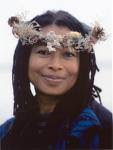
The cover of the novel is striking. It looks like a Bard that is preparing to tell a story. The blue and black tones are fitting for this novel. Blue and black are like the after effects of a hard hit, a fall, a bruise. But if the people, like the Bard, would seemingly open up and expose their hearts, a nation could become blossoming flowers.
Zakes Mda’s novel, Ways of Dying, is about post colonization, and the bruising of a war torn nation and violent people. The novel illustrates the black-and-blueness of poverty and death, pain and suffering, grief and despair. It is written with a tone of humor, and the language is light; but the message is real and poignant.
The novel is about violence. People who were once oppressed and brutalized are now the oppressors and the violators. Toloki, the main protagonist, is a "Professional Mourner." He travels the various South African settlements or townships, and he views and reports on the constant violence that he is privy to and witnesses – the fighting and the killing.
He attends funerals on a daily basis. The description of his dress is so very important. He wears a cape, a well-worn hat, and an old suit. He wears it with pride, dignity, and purpose. Toloki is, in every sense, a Bard. He records these atrocious events and delivers a message to the reader, and his function becomes clear.
In the novel, he is grieving for the deceased and their families, but the reader knows he is truly suffering because of the nation as a whole. In the novel, the deaths of people occur as a result of senseless crime, hatred, racism, and poverty. The reader senses that the picture is greater. It is about the state of South Africa. We have all heard about it and learned about it. We have all watched it on the news.
The Madonna of Excelsior had the same visual impact. I have never forgotten Mda’s imagery of apartheid in South Africa. The humiliation of Nikki in the meat market, forced to strip naked for all to see, just because a white woman accused her of stealing. Then, in the end and after all the hardship, she finds a sense of freedom with her bees. Like the imagery in The Madonna of Excelsior, the images in Ways of Dying are just as prolific. Toloki, the Professional Mourner and the Bard, is speaking to the people. The real question is: Will the people listen?









No comments:
Post a Comment